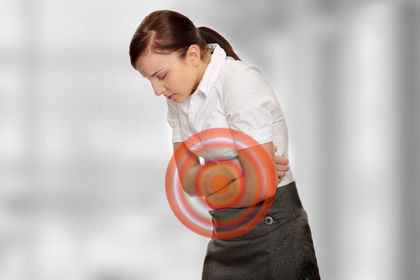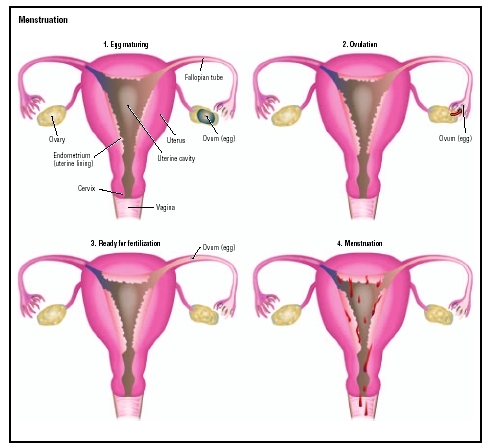Menstruation

Definition
Menstruation is the vaginal bleeding that occurs in adolescent girls and women as a result of hormonal changes. It normally happens in a predictable pattern, once a month.
Description
Menstruation is part of the menstrual cycle, which helps a woman's body prepare for the possibility of pregnancy each month. The parts of the body involved in the menstrual cycle include the uterus and cervix, the ovaries, fallopian tubes, the brain and pituitary gland, and the vagina. Certain body chemicals known as hormones rise and fall during the month, causing the menstrual cycle to occur.
In the first half of the menstrual cycle, estrogen levels rise, causing the lining of the uterus to grow and thicken. This lining is called the endometrium. The two small, grape-shaped organs inside the abdomen on either side of the uterus, known as the ovaries, are filled with hundreds of thousands of eggs and are the organs that allow pregnancy to occur. When a girl reaches puberty , the ovaries respond to a rise in follicle-stimulating hormone and cause one of the eggs to mature. About half way through the menstrual cycle, a surge of luteinizing hormone takes place, and the egg is released. This mature egg is called an ovum, and its release is called ovulation. When the egg is released it travels through one of the two fallopian tubes and down towards the uterus. If the ovum is fertilized by a sperm at this time, pregnancy occurs. However, if a sperm does not fertilize the egg, the body no longer needs the uterine lining to support the fertilized egg. Estrogen and progesterone levels then drop, triggering the uterine lining to gently fall away from the wall of the uterus, and to be shed through the vagina. The discharge of this lining is the menstrual flow. The entire process is called menstruation.
A "normal" menstrual period usually occurs every 28 days, from the first day of a period to the first day of the next. However, this can vary from 22 to 36 days. Each period usually lasts from three to seven days, with the average being five. It may take several years from the start of menstruation for periods to settle into a pattern. Irregular periods are common in early adolescence . Even after adolescence, many factors can throw off the timing of menstruation. These include weight changes, starting a new job or school, and relationship problems.
Menstrual hygiene products
Once a girl begins menstruating, she needs to choose from the various menstrual hygiene products which are available. Menstrual hygiene products can be divided into two basic categories: sanitary pads and tampons. Absorbency and a comfortable fit are the main features girls need to look for when purchasing menstrual products. Because a girl's menstrual flow may vary from day to day during the cycle, she may want to use different types of products during her period.
Sanitary pads are worn inside the underwear where they collect the menstrual flow. They come in different sizes, thicknesses, and styles. Some pads have flaps or "wings" that wrap around and attach to the underside of underwear. Others have deodorant and contain perfume. Some girls find that the perfume irritates their skin.
Tampons are the another option for absorbing menstrual flow. Tampons come in various absorbency categories and should be chosen based on the amount of flow experienced. The absorbency of a tampon can be determined by how often it needs to be changed. Girls should use the tampon with the least absorbency necessary to absorb the flow. Tampons should be changed every four to six hours. Tampons also come with a variety of applicators, including plastic and cardboard. Tampons are comfortable to wear and may be a good choice for active girls. They should be inserted carefully to avoid any irritation. A rare, but serious, condition called toxic shock syndrome (TSS) can be connected to tampon use. The higher the absorbency of tampons used, the higher the risk for TSS. To decrease the risk of TSS, girls should choose the lowest absorbency necessary.

Problems with menstruation
DYSMENORRHEA Dysmenorrhea is the medical term for menstrual cramps, the dull or throbbing pain in the lower abdomen that many women experience just before and during their menstrual periods. It can be primary or secondary. Primary dysmenorrhea involves no abnormality. Secondary dysmenorrhea involves an underlying physical cause, such as uterine fibroids, pelvic inflammatory disease, or endometriosis. Signs and symptoms of dysmenorrhea, whether it is primary or secondary, may include the following:
- dull, throbbing pain in the lower abdomen
- radiating pain to the lower back and thighs
- nausea, loose stools, sweating, and dizziness (though these are much less common)
If menstrual cramps become severe enough to keep a girl from going about her day-to-day routine, she should see a doctor. The doctor will perform a medical history and physical examination, including a pelvic exam, where he or she will look for any abnormalities, signs of infection, and possible causes of secondary dysmenorrheal. In addition, the doctor may request a variety of diagnostic tests, such as imaging tests, laparoscopy, and hysteroscopy.
Complications can arise from secondary dysmenorrhea. If pelvic inflammatory disease is present, the fallopian tubes may become scarred and possibly cause later infertility or other reproductive problems. Endometriosis can also lead to fertility problems as well.
Many experts believe that prostaglandins, hormone-like substances involved in pain and inflammation and which trigger uterine muscle contractions, are responsible for causing menstrual cramping. Whether the dysmenorrhea is primary or secondary, there are effective ways to treat menstrual pain. Nonsteroidal anti-inflammatory drugs (NSAIDS), such as ibuprofen or naproxen, may block the production of prostaglandins and can be very effective in the treatment of menstrual cramps. In the case of severe cramping, doctors may recommend a low-dose oral contraceptive to prevent ovulation, which may reduce the release of prostaglandins and the severity of the cramps.
DYSFUNCTIONAL UTERINE BLEEDING Dysfunctional uterine bleeding (DUB) is prolonged or heavy bleeding that often occurs in a menstrual cycle where ovulation did not occur. Heavy bleeding is defined as more than 15 soaked pads or tampons per period, and prolonged bleeding is that which lasts for more than 8 to 10 days. Although DUB is quite common in the first few years after menstruation starts, it can be frightening and should always be reported to a physician. DUB that is accompanied by dizziness and a low blood pressure should be considered a medical emergency. DUB is usually caused by hormonal imbalances. Other causes of bleeding are sexually transmitted disease, an ectopic pregnancy, ovarian cysts, and uterine fibroids or polyps. Young women within the first menstrual period are not usually treated unless symptoms are exceptionally severe or if anemia develops.
Demographics
Girls may start their menstrual period as early as nine years of age and as late as 16 years old. The average age a girl begins menstruating is 12. Girls who are very active in sports or who are quite thin may not develop until a later age. Losing weight while experiencing a growth spurt may also delay menstruation.
In the early 2000s, some people have voiced concern about girls starting their periods at younger and younger ages. However, a study reported in 2003 found that overall, girls in the United States are not beginning menstruation earlier than in the past. Less than 10 percent of girls start their periods before 11 years of age, and 90 percent of all U.S. girls are menstruating by age 14. This age is not significantly different than that reported for girls in 1973. African-American girls on average begin menstruating before Caucasian- and Hispanic-American girls.
Causes and symptoms
The menstrual cycle takes place each month in response to the hormonal changes which occur when pregnancy does not take place. A number of symptoms can occur just before and during a girl's period which may cause discomfort. These include:
- having pelvic area cramps
- feeling bloated or puffy
- breast tenderness or swelling
- headaches and backaches
- acne breakouts
- mild nausea
These symptoms usually stop or lessen a day or two after the period begins.
Diagnosis
There are several reasons why a girl should see her healthcare provider regarding her menstrual cycle. These include:
- if menstruation has not started by the age of 16
- if a menstrual period lasts for more than seven days
- if periods suddenly stop
- if she is experiencing excessive bleeding
- if she feels suddenly ill while using tampons
- if she bleeds more than a few drops between periods
- if she experiences excessive pain during her period
Treatment
No specific medical treatment is necessary for an uncomplicated menstrual cycle, as it is a normal, healthy process in girls and women.
Alternative treatment
Some girls may find relief from menstrual discomfort through meditation, yoga , or massage. These stress-relieving activities are unlikely to cause any harm.
Parental concerns
Though menstruation is no longer the taboo subject it once was, many parents still find that discussing the issue with their daughters can be uncomfortable. This is especially common in families in which the mother is not present. Still, it is important to discuss menstruation with girls when they are preteens, so that they do not experience the potential embarrassment or trauma if they start their first period without knowledge about what is happening to their bodies. Taking the time to prepare may help to make this discussion less awkward.
KEY TERMS
Dysmenorrhea —Painful menstruation.
Menarche —The first menstrual cycle in a girl's life.
Resources
BOOKS
Loulan, JoAnn, and Bonnie Worthen. Period: A Girl's Guide to Menstruation. Minnetonka, MN: Book Peddlers, 2001.
PERIODICALS
Chumlea, William Cameron, et al. "Age at Menarche and Racial Comparisons in U.S. Girls." Pediatrics 111 (January 2003): 110–14.
ORGANIZATIONS
American College of Obstetricians and Gynecologists. 409 12th Street, SW, PO Box 96920, Washington, DC 20090–6290. Web site: http://www.acog.org.
The Center for Young Women's Health. 300 Longwood Avenue, Box 310, Boston, MA 02115. Web site: http://www.youngwomenshealth.org.
WEB SITES
"Frequently Asked Questions about Menstruation and the Menstrual Cycle." 4woman.gov-The National Women's Health Information Center , November 2002. Available online at http://www.4woman.gov/faq/menstru.htm (accessed October 25, 2004).
"Period Talk: Preparing Your Preteen for Menstruation." Available online at http://www.mayoclinic.com/invoke.cfm?id=FL00040 (accessed October 25, 2004).
Deanna M. Swartout-Corbeil, RN